
No matter what your style of music…it seems like everyone develops a crush on the ukulele at some point.
It’s simplicity, it’s portability, and it’s universal awesomeness make it a great secondary instrument for virtually any guitar or string player.
For these same reasons, it makes a great choice for a FIRST instrument as well.
But regardless of which of these categories you fit into…
In today’s ultimate guide, I’m going to show you everything you ought to know (and nothing you don’t), as you first begin researching and comparison shopping this instrument.
First up…
Which of the 4 Common Ukulele Sizes Is Right For You?
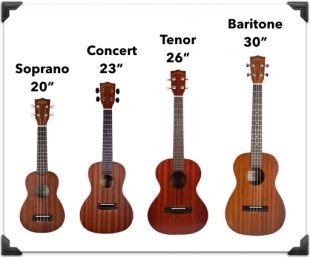
When comparing potential ukuleles…your FIRST job is to narrow down your options to 1 of the 4 common sizes:
- Soprano (20″) – the original and “classic” sized ukulele.
- Concert (23″) – offering slightly more volume/depth than a soprano because of its larger size, plus added playability for larger hands.
- Tenor (26″) – which is by far the most popular size for advanced players, perhaps because of the wider tonal rang.
- Baritone (30″) – which is the largest of the 4, but tuned differently, using the same DGBE tuning as the top 4 strings of a guitar.
The default option that most beginners start with is the soprano…since it’s not only the “standard” size, but also the cheapest and most portable.
However, the concert and tenor sizes have their own set of advantages as well, the main ones being:
- More volume
- More bass
- Better intonation
So any of those 3 will do fine as a “first uke”.
However, because baritones do not use the same GCEA tuning of the other 3, they aren’t normally recommended as a first introduction to the instrument.
Unless of course…what you really want is a mini guitar that sounds like a ukulele…as many guitar players do. In that case, a baritone is perfect.
Up next…
The 5 Essential Features That Massively Affect Sound Quality
Once you’ve settled on a particular size, the next task is to narrow your options further by comparing features.
And the most important features are those that have the biggest impact on sound/playability.
So what exactly makes one ukulele different from another? Well mainly…5 things:
- Wood
- Electronics
- Tuning System
- High/Low G string
- Brand
So let’s examine each of these features in more detail. Starting with…
1. Ukulele Woods: Koa or Mahogany?
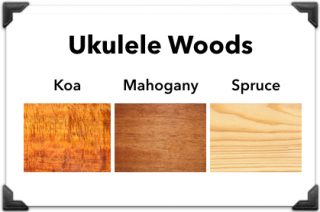
The 2 most popular ukulele woods by far are:
- Koa
- Mahogany
If you consider Hawaii to be the top authority on ukuleles (as most do)…
Its worth knowing that for most Hawaiians, koa is the one and only wood that ukuleles should ever be made from.
However…since koa does not grow naturally anywhere in the World outside of Hawaii…it’s rare to find non-Hawaiian manufacturers that regularly use this wood.
So the next most popular alternative is mahogany. Mahogany is the only other wood that can be used across (mostly) an entire ukulele and produce a sound quality that rivals koa.
Beyond these 2 woods, what you typically see is multi-wood ukuleles, which use different woods for different parts of instrument, similar to how most other acoustic instruments (such as the guitar) are made.
For example:
- Spruce/Cedar – are common for soundboards.
- Ebony – is common fingerboards and bridges.
- Rosewood – is common for sides, backs, and fingerboards.
- Mahogany – is common for necks.
Very often, these multi-wood ukuleles tend to be lower in price. But not always.
Instead, the more reliable sign of a cheap ukulele is the use of laminate wood, which hides a less-expensive wood on the inside, covered by a thin layer of better wood on the outside.
2. Electronics: Acoustic vs Acoustic-Electric
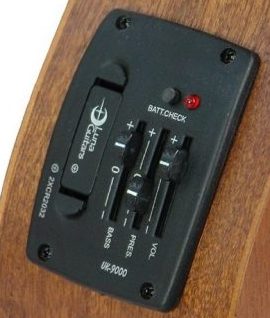
When comparing acoustic vs acoustic-electric ukuleles…
A few patterns emerge when comparing sound quality and price.
Notably…
- Acoustic ukes – usually sound better acoustically, than acoustic-electrics.
- Acoustic-electric ukes – usually sound better amped than they do acoustically.
And so, it makes sense to simply choose the option that you will be using most of the time.
In the studio, it may be easiest to record by plug into an acoustic-electric ukulele…but will almost certainly get a better sound miking up and acoustic instead. So it’s a trade-off.
3. Cheap vs Pricey Tuning Systems
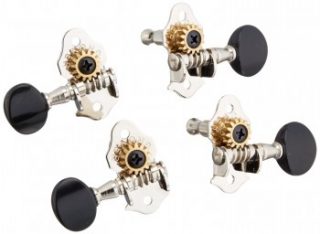
The biggest complaint that beginners have about the ukulele is that it can be insanely hard to keep it in-tune.
Especially with cheaper models…and mainly because of their tuning systems.
Ideally a good set of tuning keys will tune-up precisely and evenly, and hold their tune well.
Cheaper ones however, can be extremely unpredictable…driving advanced players insane, and leaving beginners confused and frustrated as to why their ukulele always sounds terrible.
No surprise…as price goes up…so too does the quality of the tuning keys. Typically this also means a higher turning ratio.
Cheaper models usually have a 1:1 turning ratio, where the slightest turn can result in a relatively large change in pitch (which is bad).
With higher turning ratios however, the same sized turn will result in a much smaller pitch change, ultimately allowing for more precise tuning of each string.
4. High G String vs Low G String
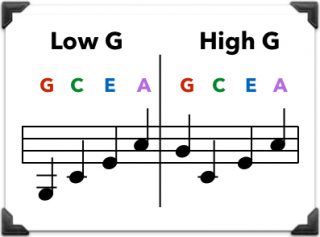
The standard ukulele tuning, known as High-G tuning…
Has a 4th string that is tuned a perfect 5th UP from its 3rd string.
Low G tuning is the common alternative to standard tuning. In this tuning, the 4th string is still a G, but an octave lower.
For beginners, the differences between these two tunings are of little consequence, since the chord shapes and strumming techniques are the same either way.
But as you get more advanced, the differences between these tuning become more apparent, and players will naturally prefer one over the other.
Logically, the Low G tuning makes more sense, because it provides more bass for your strumming, and a wider octave range for your melodies. But ultimately, every player has their own preference.
And you can easily switch between a high and low G string at anytime, because with most ukuleles, either string will fit in the nut slot (depending on how it’s cut).
The Top 6 Ukulele Brands to Know
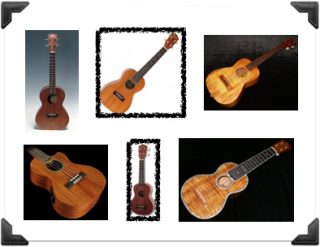
At last we’ve reached the final, and most important factor in the sound of a ukulele: The brand.
Because with this instrument specifically, the craftsmanship and skill of the manufacturer is perhaps the biggest factor in determining the overall sound quality and value.
While there are plenty of small manufacturers that make amazing ukueles, it’s difficult if not impossible for beginners to accurately assess their quality from face-value alone.
So unless you’re a ukulele connoisseur, stick with the top brands at first…at least until you know better. More specifically, I recommend checking out the following:
1. Kala
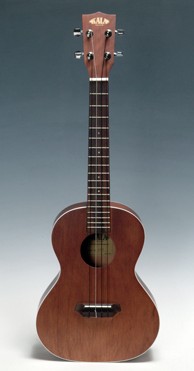
Founded back in 2005 by owner Mike Upton…
The Kala Brand Music Company is a popular mainland (not Hawaiian) company operating out of northern California.
Currently they make over 120 variations of ukuleles…
And are particularly famous for their one-of-a-kind bass ukulele known as the Kala U-Bass.
In addition, many of their most popular acoustic ukes are found in the sub-$100 range, making them a great first option for beginners on a budget.
Among these cheaper models, here are some of their most popular and well-reviewed options:
- Kala KA-15S (soprano) – (Amazon/B&H/Thomann)
- Kala KA-15C (concert) – (Amazon/B&H/Thomann)
- Kala KA-T (tenor) – (Amazon/B&H/Thomann)
- Kala KA-B (baritone) – (Amazon/B&H/Thomann)
Up next…
2. Lanikai

Part of the Hohner music company, and a currently quite popular with the indie crowd…
Lanikai is a brand owned and operated entirely out of Hawaii…more specifically from the Island of Oahu.
Using the top 1% of Koa from the Big Island, you might say that these ukuleles are about as authentically “Hawaiian” as it gets.
Interestingly enough, Jason Mraz and Robert Plant are included among the top names supporting the brand.
Now I wouldn’t call those two “ukulele players” by any means…
But then again, the average price point of a Lanikai uke is geared more towards beginners and dabblers, than toward seasoned pros.
Check it out:
- Lanikai MAS (soprano) – (Amazon)
- Lanikai MAC (concert) – (Amazon)
- Lanikai LU-21T (tenor) – (Amazon/Thomann)
- Lanikai MAB (baritone) – (Amazon)
3. Ohana
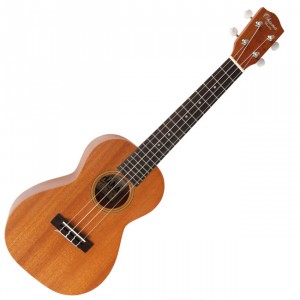
As the final 3rd option in the category of “budget brands”, we have Ohana ukuleles.
Surprisingly, several of their ukes are made of solid mahogany yet priced in the sub $200 range.
And they even have a few koa models as well.
While there is little information available online about the brand itself, rumor has it that these instruments are made in China as opposed to Hawaii or the USA…
Which isn’t necessarily a negative in itself, but it does raise some eyebrows, doesn’t it?
The biggest apparent upside of this brand is its broad distribution network all over the World, unlike many ukulele companies who only have retailers in Hawaii, the Mainland USA, and Japan.
So if you live someplace where ukuleles aren’t easy to find, this brand may be your best bet.
Here are some of their most popular models:
- Ohana SK-35G (soprano) – (Amazon)
- Ohana CK-10S (concert) – (Amazon)
- Ohana TK-10 (tenor) – (Amazon)
- Ohana BK-20CE (baritone) – (Amazon)
4. Cordoba
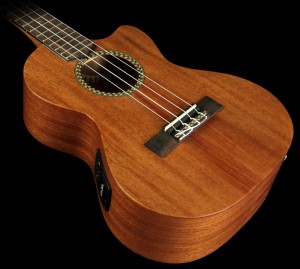
Up next we have the odd ball of the group…
A brand named Cordoba, which originally specialized solely in spanish/classical guitars.
But seeing as the instrument has so many similarities to the ukulele…
They eventually expanded their horizons and began making their own line of ukes as well…
Assigning the project lead to Cordoba designer and master builder Pepe Romero Jr.
As you can see from the picture, what they eventually created was a ukulele design all their own…
And it didn’t take long for this new line to become a massive success.
Check it out:
- Cordoba 15SM (soprano) – (Amazon)
- Cordoba 15CM (concert) – (Amazon/Thomann)
- Cordoba 20TM (tenor) – (Amazon/Thomann)
- Cordoba 20BM (baritone) – (Amazon)
5. Kamaka
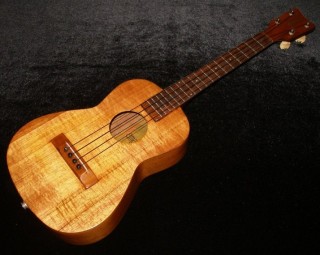
As the reigning King of all ukulele brands…
The name Kamaka has been synonymous with the ukulele ever since back in 1916…
When Samuel Kamaka started his one-man operation…
Building koa ukuleles from his home in Kaimuki, Hawaii.
After that point, it didn’t take long before Kamaka Ukulele and Guitar Works became known as makers of perhaps the highest quality ukuleles on the planet.
Not only did they sound the best…they were the most beautiful as well.
Even today…many of Hawaii’s local musicians consider Kamaka to be the one and only brand worth playing. And it is a household name, even among non-musicians.
The only downside of the Kamaka brand is that despite their amazing product, they have yet to expanded their territory very far outside of Hawaii.
So if you don’t live in Hawaii, you’re not likely to ever find one at your local music store. Or even on Amazon.
But the best place to starting searching is definitely here on Kamaka’s product page.
Here are their most popular models to check out:
- Kamaka HF-1 (soprano)
- Kamaka HB-2 (concert)
- Kamaka HF-3 (tenor)
- Kamaka HF-4 (baritone)
6. Martin
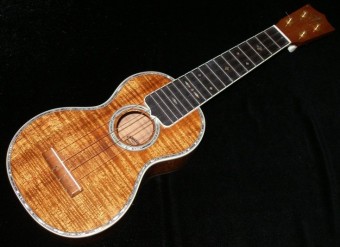
For the last brand on the list, I’ve saved the most expensive one of all: Martin.
While we all know that C.F. Martin & Co makes some of the best and priciest acoustic guitars money can buy…
You might be surprised to learn that they make some damn fine ukuleles as well.
And they’ve been doing it since back in the early 1900’s at the height of the ukulele craze.
Today, their vintage ukuleles fetch outrageous prices from collectors, and their new high-end models such as the 5k cost several thousand dollars each.
While they may not be Hawaiian made, most players agree that they just as good as any Kamaka, and some say…even better.
Here are a few of their best selling models:
So…How Much Should You Spend?
Now that we’ve gone through all of the top brands, and you’ve seen many of the best options on the market…
You may have noticed that the price ranges can vary a ton…starting as low as $50 and going all the way up to well over $1000.
The question is…how much should YOU spend, RIGHT NOW?
Assuming that you’re a total newbie, and this is your first ukulele, the best answer I can give you is…somewhere in the $150-$300 range.
In my opinion, it is in this price range that you will find the best value for your money. Anything less than $150 is a gamble. Anything more than $300, and you’re spending more than you really need to.
Having said that, we all have different budgets, so feel free to disregard this info if you think it makes sense to.
Common Ukulele Variations
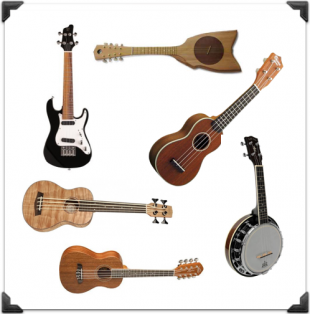
For some strange reason…the ukulele is one instrument that inspires endless spin-offs by creative manufacturers.
And while most people wouldn’t consider these “serious” instruments…
They can definitely be a source of both:
- entertainment for multi-instrumentalists, and…
- fun sounds for recording.
So let’s cover a few of them now, shall we?
- Pineapple ukes – popularized by the Kamaka family back in 1928, and similar in size to concert ukuleles, but with their own unique look and sound.
- Sopranino ukes (aka piccolo, sopranissimo, pocket uke, or bambino) – one step smaller than a soprano, and typically around 16″ in length.
- Bass ukes – one step larger than baritones, and typically around 30-32″ long. The two variations are “contrabass” ukes, with the same EADG tuning as a standard bass guitar, and “bass” ukes, with the same tuning, but one octave up.
- Electric ukes – basically just “ukulele-sized” electric guitars that use 4 strings instead of 6.
Other notable “ukulele hybrids” include:
- banjo ukuleles aka banjolele
- harp ukuleles
- lap steel ukuleles
- resonator ukuleles
- Tahitian ukuleles
- 6 or 8 string ukuleles
Up next…
How to Restring and Tune Your New Ukulele
Once you’ve finally got your hands on your new ukulele, there’s one final step before you’re ready to start playing…
You gotta string it up and tune it.
Earlier in this post we talked about how quality tuning keys are important if you want your ukulele to stay in tune. However, this is not the only factor.
Two other huge factors are:
- How you string it.
- How you tune it.
Unfortunately, the ukulele is one of the more difficult instruments to string properly, so you’ll want to take a while to make sure you understand exactly how it’s done.
So here’s a great video I found that walks you through the process step by step, whatever type of bridge and headstock you have:
By the way, if you found this post useful, I highly recommend joining our free Home Recording Secrets email newsletter where you’ll discover….
- How to Get Your First Studio Up and Running in a Single Weekend
- How to Avoid Wasting Thousands of Dollars on Unnecessary Pointless Purchases
- How to Get a “Million Dollar” Pro Studio Sound in a “Thousand Dollar” Home Studio
- PLUS… All Sorts of Other Amazing Insider Secrets Revealed
And it’s totally FREE! Click here and Enter Your Email to Sign Up.
Similar Posts in this Series:
Ukuleles | Electric Ukuleles | Bass Ukuleles | Ukulele Strings | Violin | Autoharp | Mandolin | Banjo | Dulcimer